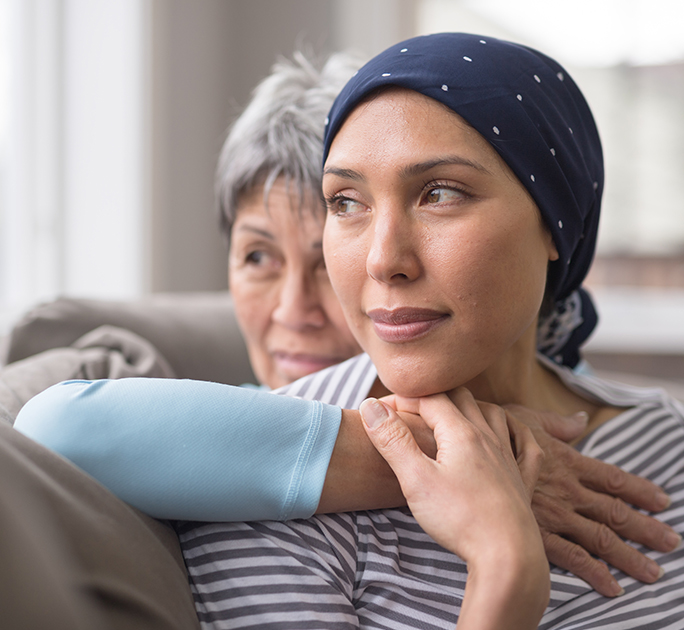Tackling costs of cancer treatment
By Lorna Tan
![]()
If you’ve only got a minute:
- Cancer treatment costs in Singapore depends on the treatment required and can be expensive.
- Medical insurance such as MediSave, MediShield Life and Integrated Shield Plans (IPs) cover hospital bills, but not daily expenses. They may not be enough.
- DBS is providing complimentary critical illness coverage. Sign up to be insured for 6 months with complimentary ProtectFirst while you review your critical illness insurance needs.
![]()
In an ideal world, cost would not be an obstacle to anyone receiving medical help, such as cancer treatment which could run up to a significant amount. In reality, there are many stories of individuals who suffer from “financial toxicity” that may come about when they are financially ill prepared to manage a severe sickness, unable to foot their medical bills or in a worst case scenario, forgo treatment to avoid burdening their loved ones.
A recent survey of 1,200 Singapore residents indicated that 42% or about 4 in 10 of respondents said they would not be financially prepared to manage the costs of cancer treatment. Conducted in August and September 2023, the study was commissioned by DBS Bank, designed by National University Cancer Institute, Singapore (NCIS) and Research For Impact (RFI), and conducted by Blackbox Research.
The study aimed to assess not only the awareness of potential costs associated with a cancer diagnosis, but also the understanding of its financial implications, emphasising the critical role of financial literacy. The key reason cited for not getting cancer insurance was unaffordable premiums..
Even among those with health and/or critical illness insurance, the survey showed that only 5% were “very confident” that their policies could fully cover the cost of cancer treatment.
A separate earlier study by NCIS and RFI - which focused on cancer survivors in Singapore - showed that patients of lower socioeconomic status were found to be at higher risk of financial toxicity.
Fortunately, there are ways to minimise the financial burden of cancer treatment such as ensuring adequate insurance protection. And as the healthcare landscape evolves, it helps to be empowered with knowledge of insurance coverage and understand what they are covered by their own insurance plans, including the terms and conditions, and exclusions.

Critical illness or cancer insurance plans
Integrated Shield Plans (IPs) – which mainly cover your hospital bills - can be added to your MediShield Life policy for additional coverage of the costs of private hospitals or class B1 or A wards in public hospitals.
IPs typically cover the bills for cancer treatment in Singapore, such as biopsies, chemotherapy, and surgery. Since April 2023, IPs are required to only cover cancer treatments and drugs that are on the MediShield Life’s Cancer Drug List (CDL) of clinically proven and cost-effective cancer drug treatments and set claim limits for each cancer drug treatment.
However, IPs do not provide a lump sum payout in the event of a diagnosis, unlike critical illness and cancer insurance plans. As such, if your regular source of income is affected by an illness, an IP will be able to cover hospital bills, but not your daily expenses.
Comprehensive private health insurance is a broader option if you can afford it. However, they may not have adequate coverage for cancer. For coverage specific to cancer, there are policies that are generally cheaper than comprehensive health coverage.
Critical illness plans typically provide a lump sum payout in the event of more than 30 late-stage critical illnesses including cancer, while cancer insurance is a type of critical illness insurance plan that provides a lump sum payout across all stages.
For both types of insurance plans, the policyholder can use the payouts to offset whatever he wishes such as going for a holiday to recuperate, seeking alternative medical treatment overseas and so on. In that sense, critical illness or cancer insurance plans are like a booster shot to your finances when dealing with the cost of cancer treatments and recovery.

Raising financial literacy as part of the solution
The two studies highlight a correlation between household income, perceived financial preparedness, and our understanding of and confidence in insurance plan.
Individuals may be unaware of or are unprepared to cope with financial toxicity because of the lack of awareness about the consequences, limited health/financial literacy, or insufficient resources. Only 33% of the 1,200 respondents in the financial readiness study were aware of the recent changes to the financing of outpatient cancer treatment based on the CDL, which had been announced prior to the survey.
Respondents who perceived themselves as “highly financial literate” were less likely to anticipate delaying or foregoing cancer treatment due to cost concerns. As such, empowering more people with financial knowledge and raising awareness of available coverage would give them the confidence to prepare for unpredictable “catastrophic” medical expenditure and income loss, allowing them to focus on their treatment should they become unwell.

Cancer statistics
One in 4 Singaporeans may develop cancer in their lifetime1. The incidence rate of cancer has also risen more rapidly among the younger age groups aged below 40, as compared to the older age groups2.
Singapore Cancer Society stated that from 2017-2021, an average of 46 people were diagnosed with cancer and 16 people died of cancer everyday in Singapore3. However, with early detection and treatment, patients can have better clinical/management outcomes.
Two breast cancer survivors, Jamie Yeo, ex-Mediacorp Artiste and popular host and radio DJ and Lay Teng share their experience with breast cancer in an interview by Breast Cancer Foundation.
Cancer accounted for 60% of critical illness claims received by Manulife from 2018 to 2023. And there was a 6% increase in younger people (age 35 and below) who made critical illness claims in 2022 as compared to 20183.
Here are some cancer statistics in Singapore, based on the top 10 cancers for each gender.
10 most common cancers in Singapore by gender (2017-2021) (as at 20 Jan 2024)
| Men | Women | ||
|---|---|---|---|
| No. of cases | No. of cases | ||
| Prostate | 6,912 | Breast | 12,735 |
| Colon & rectum | 6,697 | Colorectal & rectum | 5,542 |
| Lung | 5,567 | Lung | 3,388 |
| Lymphoid neoplasms | 2,986 | Corpus uteri (uterus) | 3,133 |
| Liver | 2,984 | Lymphoid neoplasms | 2,221 |
| Non-melanoma skin | 2,136 | Ovary & fallopian tube | 1,855 |
| Kidney | 1,734 | Non-melanoma skin | 1,713 |
| Stomach | 1,684 | Thyroid | 1,666 |
| Myeloid neoplasms | 1,430 | Pancreas | 1,187 |
| Pancreas | 1,417 | Stomach | 1,111 |
Source: Singapore Cancer Society4

Cost of cancer treatment in Singapore
Chemotherapy treatment usually happens in repeating cycles, in which a treatment period is followed by a period of rest. Depending on how complex your treatment plan is, chemotherapy treatment cycles could be weekly, or take place every 2, 3, or 4 weeks5. Typical cancer treatment requires 4 to 8 cycles. For others, you may need more than one course of chemotherapy treatment.
To give you a better idea of treatment costs in Singapore, we have compiled the cost of procedures related to cancers.
| Condition/Procedure | Hospital Bill (Overall) (Based on transacted bills from 1 Jan 2021 to 31 Dec 2021) |
||
| Public hospitals / centres (Subsidised) | Public hospitals / centres (Unsubsidised) | Private hospitals / clinics | |
| Abdomen, lining, cancer, surgical removal | Ward B2: S$6,427 Ward C: S$7,489 |
Ward A: S$26,898 | |
| Airway, Lungs abnormal growth with very severe complications | Ward B2: S$3,194 Ward C: S$2,738 |
Ward A: S$8,832 Ward B1: S$7,088 |
Inpatient: S$28,108 |
| Blood, cancer of the blood and lymph nodes without very severe complications | Ward B2: S$2,329 Ward C: S$2,099 |
Ward A: S$8,363 Ward B1: S$3,498 |
Inpatient: S$13,710 |
| Breast cancer, malignancy with catastrophic or severe complications | Ward B2: S$2,113 Ward C: S$1,534 |
Ward A: S$3,193 Ward B1: S$3,707 |
Inpatient: S$5,039 |
| Cancer of liver, gall bladder, bile duct or pancreas with catastrophic complications | Ward B2: S$3,410 Ward C: S$2,467 |
Ward A: S$9,970 Ward B1: S$7,669 |
Inpatient: S$33,642 |
| Colonoscopy with removal of tissue or abnormal growth with scope | Day Surgery: S$1,751 | Day Surgery: S$6,171 | Day surgery: S$8,184 |
| Female reproductive tract, removal of uterus, ovary, Fallopian tubes, and abdomen lining for diagnosis and treatment of cancerous growth | Ward B2: S$5,584 Ward C: S$5,493 |
Ward A: S$20,238 Ward B1: S$17,696 |
Inpatient: S$37,719 |
| Kidney and urinary system cancer with catastrophic or severe complications | Ward B2: S$2,665 Ward C: S$2,214 |
Ward A: S$8,213 Ward B1: S$7,550 |
Inpatient: S$14,928 |
Source: Ministry of Health6
Note: Figures shown are based on the median fee, i.e., what 50% of patients are charged below. They provide an estimate and may not add up. Typical bill items: Operation fee, Surgeon Fee, Anaesthetist Fee, Facility Fee, others.
As Jamie and Lay Teng described in the video above, both the patient and their families go through an emotional roller coaster when cancer strikes. An insurance policy helps to ease the burden on finances so that the focus is on getting back on track.
It is prudent for everyone to review our insurance needs regularly in the light of family medical history and individual circumstances. Moving ahead, policymakers, clinicians, medical social workers, and financial professionals have crucial roles to play in mitigating the impact of financial toxicity on cancer patients and their families.
Furthermore, MediShield Life could be further fine-tuned to ensure it remains relevant and robust over the years. With 70% of the population covered by IPs, insurers would do well to enhance them too.
DBS has partnered with major insurers in Singapore to make health insurance easily accessible online for purchase. You can now independently learn, compare and buy a plan most suited to your own needs. Find out more on DBS Health Marketplace.
Go on and find the most suitable plan based on your needs and budget. Meanwhile, we want to be sure that you have some basic insurance coverage because the unexpected can strike anyone, at anytime.
DBS has partnered with major insurers in Singapore to make health insurance easily accessible online for purchase. You can now independently learn, compare and buy a plan most suited to your own needs. Find out more on DBS Health Marketplace.
Ready to start?
Check out digibank to analyse your real-time insurance coverage. The best part is, it’s fuss-free – we automatically work out your gaps and provide planning tips.
You may also wish to speak to the Wealth Planning Manager today for a financial health check and how you can better plan your finances.
Footnotes and sources:
1Prime Minister’s Office Singapore. (2023, May 23). DPM Lawrence Wong at the Official Opening Ceremony of the New National Cancer Centre Singapore. https://www.pmo.gov.sg/Newsroom/DPM-Lawrence-Wong-at-the-Official-Opening-Ceremony-of-the-New-National-Cancer-Centre-Singapore
2Renald Loh. (2023, September 18). The Big Read: For young adults with cancer, battling an ‘old person’s disease’ is a lonely journey. https://www.channelnewsasia.com/singapore/young-adults-battling-cancer-lonely-journey-big-read-3775741
3Based on data collected by Manulife, as of 31 January 2024.
4Singapore Cancer Society. Common Types of Cancer. https://www.singaporecancersociety.org.sg/learn-about-cancer/cancer-basics/common-types-of-cancer-in-singapore.html
5Cancer Research UK. (2023, June 26). Treatment cycles and courses of treatment. https://www.cancerresearchuk.org/about-cancer/cancer-in-general/treatment/cancer-drugs/how-you-have/treatment-cycles-and-courses
6Ministry of Health Singapore. Hospital Bills and Fee Benchmarks Search Result. https://www.moh.gov.sg/cost-financing/hospital-bills-and-fee-benchmarks-search-result
7Promotion terms and conditions apply. Your coverage is subject to policy terms and conditions. Please refer to the product summary for more information.
8You will receive 100% of the critical illness (CI) coverage amount in the event of advanced stage cancer, heart attack, stroke, liver failure or major organ/bone marrow transplant. 25% of the CI coverage amount can be paid in advance for early or intermediate stage, and remaining CI coverage amount to be payable upon advanced stage. Once 100% of the CI sum insured has been paid, this benefit will terminate, and premium reduces.
Disclaimers and Important Notice
This article is meant for information only and should not be relied upon as financial advice. Before making any decision to buy, sell or hold any investment or insurance product, you should seek advice from a financial adviser regarding its suitability.
This advertisement has not been reviewed by the Monetary Authority of Singapore.
This article is not intended for distribution to, or use by, any person or entity in any jurisdiction or country where such distribution or use would be contrary to law or regulation.
In Collaboration with Manulife
ProtectFirst is issued and underwritten by Manulife (Singapore) Pte. Ltd. (“Manulife”) (Reg. No. 198002116D) and distributed by DBS. It is not an obligation of, deposit in or guaranteed by DBS.
Terms and conditions apply, please refer to product summary for more information. The benefits payable under the serious accident coverage benefit are subject to the occurrence of an accident during the policy period.
This policy is protected under the Policy Owners’ Protection Scheme which is administered by the Singapore Deposit Insurance Corporation (“SDIC”). Coverage for the policy is automatic and no further action is required from you. For more information on the types of benefits that are covered under the scheme as well as the limits of coverage, where applicable, please contact Manulife or visit the Life Insurance Association or SDIC websites (www.lia.org.sg or www.sdic.org.sg).








That's great to hear. Anything you'd like to add? (Optional)
We’re sorry to hear that. How can we do better? (Optional)